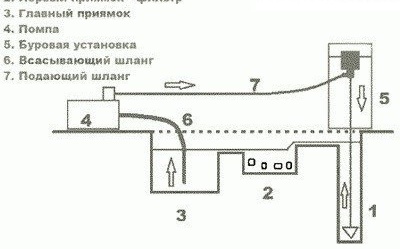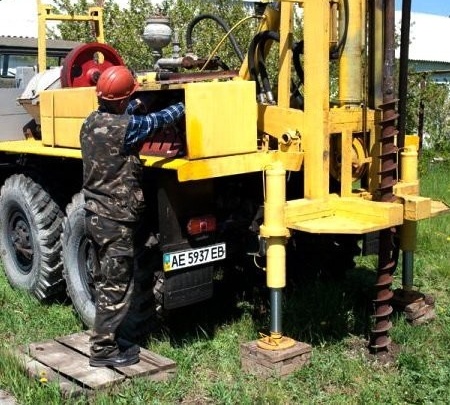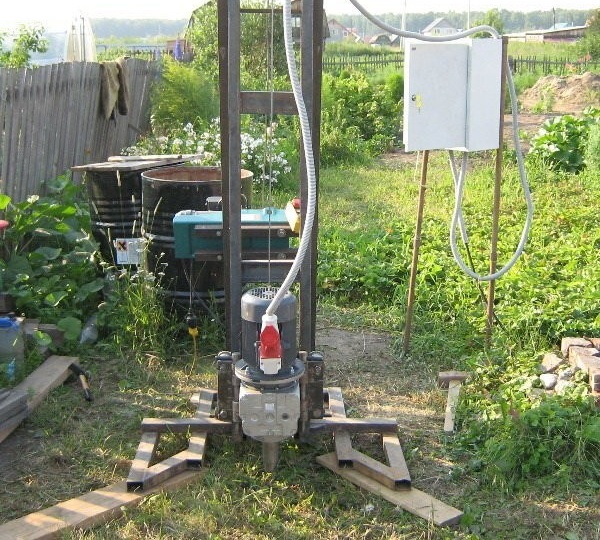Review of technology for hydraulic drilling - is it possible to carry out the work yourself?
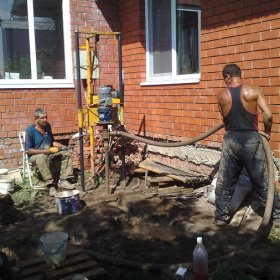
An autonomous water supply system is often almost the only way to arrange water supply for country houses or cottages. As a source, a well is often chosen, which is equipped on the site. The desire of the owner to conduct the arrangement process with minimal losses for the territory, especially if it is already ennobled, and the wallet is quite understandable. In this case, it is worth using do-it-yourself hydro-drilling or, if there is no experience in such work, with the involvement of specialists.
This drilling method is based on the method of destruction of soil by means of a liquid and a drilling tool. The necessary load is provided by the weight of the rods and special drilling equipment, with the help of which drilling fluid is pumped into the well, or as it is also called flushing fluid. It is a suspension of clay and water. Near the drilling site, pits 1x1 m in size are dug. They are filled with drilling fluid. The pits are necessarily interconnected by trays.
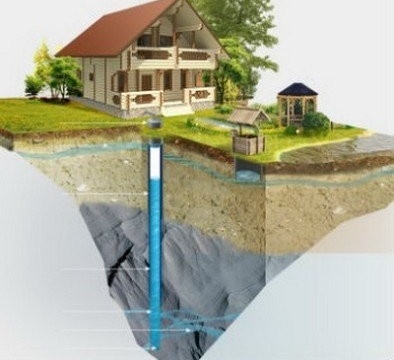
Hydro-drilling is a fairly simple and effective way of punching a well, which will become the basis of an autonomous water supply system
Flushing fluid is supplied to the face. To do this, the outlet hose connected to the motor pump is immersed in the pit. Its output is connected to the swivel. The drilling fluid located in the pit is taken by a motor pump and directed under pressure to the well. The flushing fluid washes out the slag obtained by drilling, cools the drilling tool and polishes the surface of the well. As you move deeper into the work string is increased by additional sections of drill rods. Upon reaching the optimum depth, the well is washed with water and a swing pump is installed in it.
Content
What do you need to cook for work?
Hydro-drilling of wells is carried out using a small-sized installation or MBU. Those who are used to associating the drilling process with bulky mechanisms will be surprised that this device is a rig three meters high and one meter in diameter. The structure of this prefabricated structure includes:
- collapsible metal frame;
- drilling tool;
- winch;
- an engine that allows you to transmit the force to the drill;
- swivel - part of the working circuit, providing sliding fastening to other parts;
- water pump, which creates and maintains pressure in the system;
- drill for the passage of soil, may be exploratory or lobed;
- drill strings forming a string;
- hoses supplying water from the motor pump to the swivel;
- unit control unit.
You will need a current converter, which is necessary for the uninterrupted supply of equipment with electricity, a winch for lowering and raising the typesetting and casing pipes. The device can be built into the MBU, this point will need to be clarified. Choosing a gasoline motor pump for pumping drilling mud, it is better to take a sufficiently powerful high-quality apparatus, since the load on it will be large. Will need casing, a filter and a small tool, which includes a pipe wrench, transfer plug, hand clamp, etc.
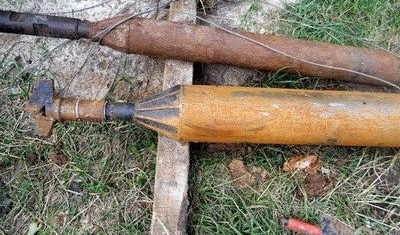
A standard drill is used for drilling a well, but depending on the type of soil, special varieties of it may be required.
What is the best place to start?
Before you start drilling, you need to roughly determine at what depth is the aquifer. This is necessary to clarify the complexity of the upcoming work and the preparation of the required number of casing pipes. The easiest way to get acquainted with the specifics of local soils is to contact the local land authorities where geodetic maps should be stored. In a good way, even with shallow digging, it would not be out of place to get a special document from the center for sanitary and epidemiological conclusions. With the help of such specialists, you can get the full amount of laboratory and instrumental research for putting into operation various construction projects.
In addition, it is necessary to determine the source of water from which the drilling fluid will be taken. It should be borne in mind that on average, depending on the composition of the soil and the depth of the well for drilling, it takes from 5 to 20 cubic meters of water.
The next step is preparing the site. You need to start with preparing a supply of water. You can stock up on additional containers about 2 cubic meters in size. You can go the other way: dig a hole five or more cubic meters, treat its walls with a clay solution and pour water into it. Then the MBU is installed. The assembly procedure is extremely simple and takes about an hour. The main condition is to expose the device strictly horizontally. Even a slight bias will not allow subsequently to establish a casing. In 1-1.5 meters from the structure, technological recesses, the so-called pits, are arranged. They will contain drilling fluid.
Priyamkov should be two. One of them will act as a filter. It is located closer to the drilling rig. The dimensions of the pit filter can be about 0.7 m in length, depth and width. The main pit, slightly larger, is located a little further. It connects to the filter with a small trench or tray. A motor pump is installed near the main pit. The hose coming from its inlet should be lowered into the main pit. A hose extends from the outlet of the device to the rig. Using the rod, it connects to the swivel, through which drilling fluid will be supplied to the well.
Technology of work
Experienced workers recommend starting water drilling in the morning, since the process usually takes a lot of time and can even take several days. The soil is different everywhere, respectively, and various nuances are possible in working with it. Let's talk about sandy soils. For drilling in such a soil, it is necessary to prepare the maximum supply of water, since work with sand involves a large absorption of fluid. Immediately before starting work, you need to knead the clay solution.
To do this, clay is loaded into the pit with water and mixed with a mixer. The consistency of the liquid should resemble kefir. When such a drilling fluid enters the well, it does not go into the sand like ordinary water, but gradually clogs the walls of the hole, forming a kind of vessel. Be sure to check the health of the winch, pump for pumping water and other tools.Since in the process of punching sandy soil stops are impossible. The casing must be lowered immediately, otherwise collapses are possible and work will have to start almost from the beginning.
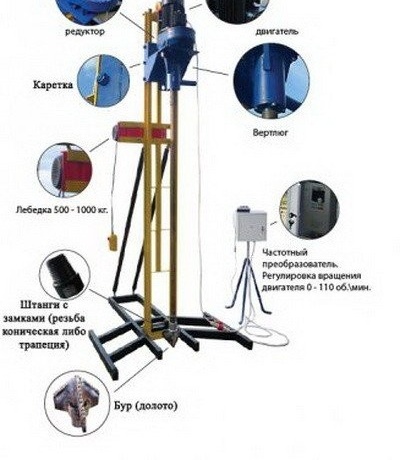
The diagram shows the design of a small-sized drilling rig, with the help of which hydraulic drilling is carried out
The hydraulic drilling procedure is quite simple. Motor pump delivers drilling fluid into the hoses. Through the swivel, the liquid enters the rods, to the working drill. The solution polishes the borehole walls, which makes them stronger, acts on the drilling tool, helping it to pass through the rock, and cools the elements of the installation. After working off, the liquid is discharged into the pit filter. In this tank, soil trapped in water from the well will settle to the bottom, and the cleaned drilling fluid will flow over the tray into another pit. Now it can again be used in the process of operating the MBU.
A small nuance: the composition of the drilling fluid depends on the type of soil. If during the course of work it is clear that the soils are changing, adjustments should also be made to the composition of the drilling fluid. The drilling process continues until the aquifer is reached. If one rod is not enough, you can add the following until reaching clean water. Manufacturers of MBUs usually guarantee the operation of their device at a depth of 50 m. However, in practice, craftsmen use these facilities to punch wells up to 120 m deep. After reaching the aquifer, the well is washed with plenty of clean water.
Features of casing installation
After flushing the well, the drill rods are carefully removed. It must be borne in mind that if parts are lifted heavily, then flushing was insufficient. Now you can install the casing. They can be metal, asbestos-cement or plastic. The latter option is the most widespread, because it is very durable, not subject to corrosion and deformation. Most often, pipes with a diameter of 125 mm are installed, for shallow wells, the option of 116 mm is suitable. Sufficient wall thickness of parts - 5-7 mm.
For better quality of the supplied water and its additional cleaning from dirt, filters are used: with spraying, slotted or homemade. In the latter case, the simplest option can be considered as follows: with the help of a grinder, gaps are made across the entire casing. To make a filter of higher purification, a lot of holes are drilled in the pipe, then the part is wrapped with a special mesh or geo-fabric for better filtration, everything is fixed with clamps. The casing with the filter at the end is lowered into the well.
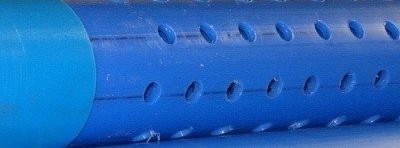
A downhole filter of this type can easily be made independently. To do this, holes are drilled in the casing, which are better to close with a layer of geotextile or a special mesh
If the installation is complicated by the presence of a strong water carrier, which quickly “closes” the wells, you can try the following. Slots are cut in the tip screwed onto the filter or holes are drilled. A head is put on the pipe to which the pressure hose from the pump is attached. Then the most powerful water pressure is turned on. After these manipulations, the casing should easily enter the aquifer. After installing the casing as an additional filter, half a bucket of gravel can be poured into the column.
The next action is the next flushing of the well. This is necessary to erode the aquifer, which was saturated with drilling mud during drilling. The operation is performed as follows. A head is put on the pipe, a hose from the motor pump is fixed, and clean water is fed into the well. After washing, the column is evenly and densely covered with gravel. Now on the cable you can lower the pump and use the well. A small nuance: the mechanism must not be lowered to the bottom, otherwise it will fail very quickly. The optimum depth is just below the water column.
The process of hydrodrilling a well for water is quite simple and quite accessible for independent execution. However, before starting work, you need to carefully study the instructions, and best of all, take part in the drilling under the guidance of specialists. Despite the apparent simplicity, there are many nuances known only to professionals. If there is no experience or desire, you can invite specialists who will quickly penetrate the well and equip it quite quickly and at an affordable cost. The owner will only have to rejoice in the emergence of an autonomous water supply system in his home.
